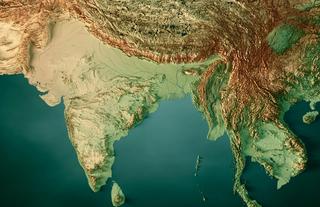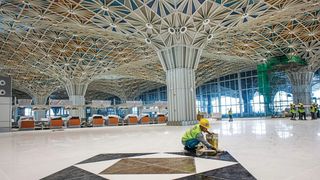Australia’s engagement in the Indian Ocean Region (IOR) has been growing beyond its defence commitments. A lesser known, but equally crucial aspect of its regional engagement is its connectivity and infrastructure programs, embodied in the South Asia Regional Infrastructure Connectivity (SARIC) framework. Announced in 2019, with implementation beginning in 2020, SARIC is a $32 million, four year-long strategic initiative aimed at enhancing connectivity and infrastructure development for regional prosperity in South Asia. Followinga mid-term review (MTR) in January 2024, plans are underway to extend the program for five years, signalling Canberra’s continued commitment to South Asia’s infrastructure future, which was also underscored in the Department of Foreign Affairs and Trade’s (DFAT) 2023 International Development Policy.
Partnering with the World Bank and the World Bank Group’s International Finance Corporation (IFC), SARIC focuses on developing pipeline projects in the transport and energy infrastructure sector in Bangladesh, Bhutan, Maldives, Nepal, India and Sri Lanka. This effort also aligns with those of Australia’s other partners in the region, including the United States, India and Japan, on leveraging infrastructure for regional growth and security.
Strengthening regional connectivity: The SARIC framework and its key focus areas
South Asia is home to nearly two billion people and serves as a crossroads for critical maritime and overland trade routes. Yet it is one of the least connected regions in the world, where intra-regional trade accounts for 5% of the region’s global trade, compared to 22% in Sub-Saharan Africa and 50% in East Asia. The region faces vast infrastructure deficits that hamper its economic potential and increase the risk of regional geopolitical competition. According to the MTR, South Asia would need an average infrastructure investment of US$400 billion per year to support sustainable growth and climate resilience. In response to these challenges, several initiatives at both the multilateral and bilateral levels have been launched in the region, including by India, the United States, Japan and China.

Australia’s SARIC framework also aims to address key connectivity and infrastructure gaps. It outlines two specific goals:
- To develop a pipeline of transport and energy projects for strengthening intra-regional connectivity in South Asia, with potential financing from both public and private sources.
- To offer short-term training and networking opportunities, enabling individuals and institutions to contribute to cross-border collaboration and the advancement of connectivity projects.
SARIC is not Australia’s first venture into South Asian infrastructure and trade facilitation. Canberra has previously supported other World Bank-administered programs such as the South Asia Regional Trade Facilitation Program (SARTFP) between 2016-2021, and the multi-donor South Asia Water Initiative (SAWI) between 2013-2021. The primary focus in both programs was strengthening policy analysis and technical capacity in the region in specific areas. Through SAWI, 1,983 professionals were trained in addressing cross-border, water-related challenges in Bangladesh, Bhutan, India and Nepal (BBIN). The SARTFP has in turn enabled conversations on strengthening women’s participation in cross-border trade.
Compared to the previous programs, SARIC’s scope is wider, with a focus on transport, energy and capacity building to drive regional integration, while also focusing on the roles of the private and public sector. It also involves more hands-on engagement from DFAT, as described through the delivery components, including a monitoring and evaluation framework (Table 1). This effort is linked to broader goals, such as reducing poverty, enhancing regional stability, and fostering sustainable development, making it a more comprehensive effort.
Collaborative mechanisms and projects
SARIC has three delivery components, each with a separate partner and specific fund allocation (see Table 1).
Table 1: SARIC’s delivery components (2020-2024)
Source: SARIC
Under Component 1, the IFC works with regional governments to promote private sector-led projects. Under Component 2, the World Bank works with the government to support public investments and inform policy. Under Component 3, a training provider is contracted to manage the training courses for individuals and build networks between South Asia and Australia. Table 2 lists the current projects under Component 1 and 2 of the SARIC framework. A Working Group - comprised of all the delivery partners (World Bank, IFC, Palladium, Adam Smith International) and DFAT’s missions in Dhaka, New Delhi and Kathmandu - is responsible for the governance and internal coordination of the SARIC programme. As per the SARIC operations manual, this includes discussing training methodologies with Palladium and managing internal evaluations conducted by Adam Smith International.
Table 2: SARIC Projects 2020-2024 (Components 1 and 2)
Source: SARIC and Mid-Term Review.
#As of June 2024
Around 60% of the SARIC projects are concentrated in Bangladesh, with varying degrees of impact. For example, the InfraLEAP Temperature Controlled Logistics project in Bangladesh resulted in the creation of the country’s first national-level body, the National Logistics Development and Coordination Committee. Meanwhile, the Bhutan Sustainable Hydropower Development Project has sparked sub-regional discussions among power secretaries from Bangladesh, Bhutan, India and Nepal, contributing to cross-border cooperation in energy development.
In terms of training and capacity building, until June 2024, approximately 200 individuals were trained under SARIC on areas such as road safety, customs procedures, port management and cargo handling. This has enabled the creation of a network of experts that engage both at a cross-border level and with Australian experts.
While the strength of the SARIC programme pivots on its decades of World Bank and IFC regional engagement, its reliance on established processes slows implementation, often leading to delays in approvals and progress. As a result, a mid-term review conducted by DFAT in January 2024 reported that there was significant unspent money three years into the program in September 2023.
How does SARIC compare to other South Asia regional integration efforts?
Australia’s SARIC program is not just about a development partnership — it is a strategic move to strengthen its presence and influence in South Asia, a region of growing economic and geopolitical importance. However, Australia is not the only country invested in the region. Its Quad partners – the United States, Japan and India – also contribute to strengthening regional integration, often at a much larger scale.
For instance, through its Development Finance Corporation (DFC), the United States is supporting various infrastructure and transportation projects including strengthening logistics in Nepal through the Dolma Impact Fund II and contributing US$54 million to India’s National Investment and Infrastructure Fund. More recently, the DFC committed US$553 million to finance the Colombo West International Container Terminal in Sri Lanka, which is being developed by India.
Similarly Japan, as part of its ‘Free and Open Indo-Pacific’ (FOIP) policy, is building the Matarbari Deep Sea Port in Bangladesh, at a cost of US$1.5 billion, out of which Japan is providing US$1 billion.Apart from this, there are 16 grant-aided projects, including on capacity building in coastal and inland waterways and urban infrastructure. Japan’s contribution also includes 31 concessional loan projects focussed on infrastructure development in the country.
India is also deeply invested in its immediate neighbourhood, driven by its ‘Neighbourhood First’ and ‘Act East’ policies that aim to strengthen connectivity. India contributes the largest amount of development assistance to its neighbours, approximately 75% of which is focussed on infrastructure. Additionally, India has also extended Lines of Credit – a type of concessional loan worth approximately US$16 billion – cumulatively to Bangladesh, Nepal, Sri Lanka, Myanmar and the Maldives.
By comparison, while Australia acknowledges the strategic significance of infrastructure development and multi-modal connectivity in the region, its engagement has been modest and largely routed through multilateral channels.
Opportunities to strengthen SARIC
As regional competition in infrastructure development intensifies, Australia’s cautious contribution on this front must evolve for Australia to maintain its relevance in shaping Indo-Pacific connectivity and to strengthen its presence in the IOR. Despite its modest scale, SARIC has put Australia on the map of regional efforts, bringing it closer in line with the efforts of its Quad partners. At a bilateral level, it has also strengthened Australia’s relationship with India, given SARIC’s efforts reinforce India’s own regional connectivity initiatives.
Australia’s SARIC program is a key pillar of its broader Indo-Pacific strategy and commitment to regional development. Despite challenges, SARIC’s long-term impact on connectivity, economic integration and development will be significant. By addressing geopolitical competition in regional infrastructure development, it strengthens multilateral partnerships while offering smaller countries more options in choosing development partners. The framework not only serves Australia’s economic and strategic interests, but complements other South Asian connectivity efforts to foster stability, prosperity and sustainable growth in one of the world’s most dynamic regions.
Beyond its current mandate, SARIC could broaden its engagement in Training and Networking Services from a focus on transport and energy sector professionals to engagement with local communities and civil society organisations. This will ensure that infrastructure projects are inclusive and benefit a large section of the population. This is crucial given the intensifying competition, especially with China’s Belt and Road Initiative, which has gained an edge by swiftly mobilising resources. SARIC, with its focus on sustainability and transparency, must strike a balance between its various components and prioritise the implementation of projects efficiently and at scale.






